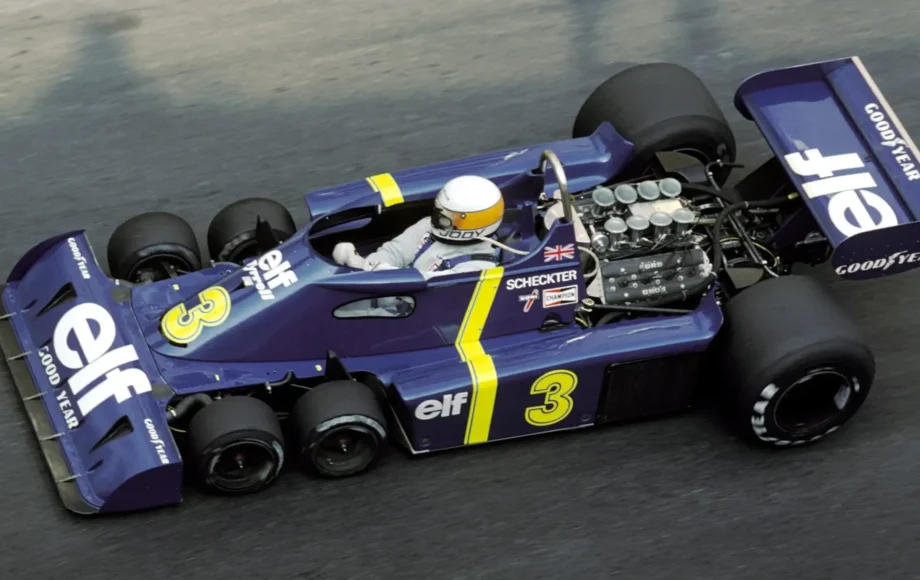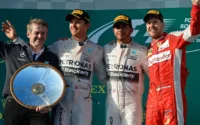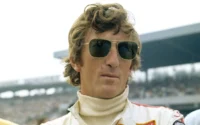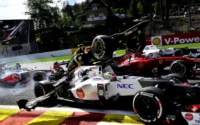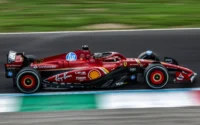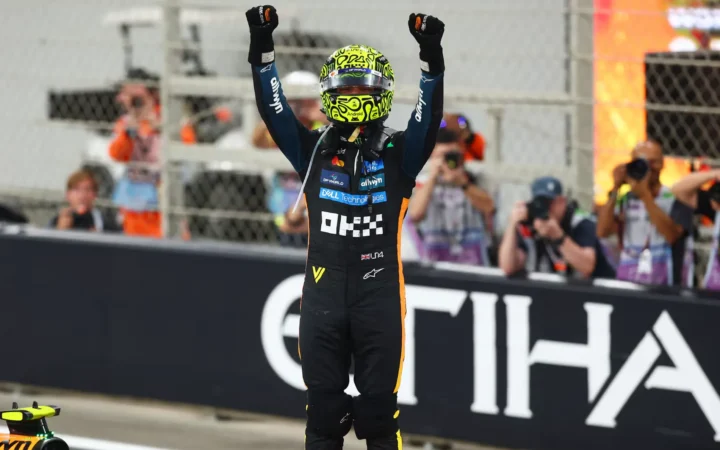Few Formula One cars have ever stopped the paddock in its tracks quite like the Tyrrell P34. When Ken Tyrrell pulled the covers off his team’s new challenger in late 1975, the sight was so extraordinary that onlookers reportedly stood frozen. Where two wheels should have been, there were four. Six wheels in total. It looked like a toy someone had cobbled together in a shed. Yet, behind the surprise lay one of the most fascinating and ambitious design stories in F1 history.
What To Know?
- The Tyrrell P34 remains the only six-wheeled car ever to win a Formula One Grand Prix.
- Designed by Derek Gardner to reduce drag and improve grip with four small front wheels.
- Its victory came at the 1976 Swedish Grand Prix with Jody Scheckter leading a Tyrrell 1–2.
- The concept was abandoned after 1977 due to tyre development issues and rule changes.
By the mid-1970s, Formula One had settled into an age of mechanical conformity. Almost every team on the grid, with the exception of Ferrari, relied on the same Cosworth DFV engine and Hewland gearbox combination. Chassis designs varied, but the underlying ingredients were remarkably similar. Innovation had to come from the margins, and in a sport built on finding “unfair advantages”, that pushed designers to ever more creative corners of the rulebook.
Derek Gardner, chief designer at Tyrrell, was a man who relished a challenge. Having previously worked on four-wheel-drive projects for Matra and Lotus, he understood the delicate relationship between traction, aerodynamics and balance. The regulations at the time stipulated that the front wing could not exceed 1.5 metres in width, which left the standard front tyres poking out into the airflow. That was bad for both drag and downforce.
Gardner’s solution was to make the front wheels smaller, narrow enough to tuck in behind the front wing. Smaller tyres would mean less frontal area and a cleaner flow of air. But to compensate for their reduced grip, he simply doubled their number. Four tiny front tyres would restore the contact patch lost through miniaturisation while keeping the airflow tidy. It was an elegant equation, and when Gardner presented it to Ken Tyrrell, the famously pragmatic team boss saw enough promise to say yes.
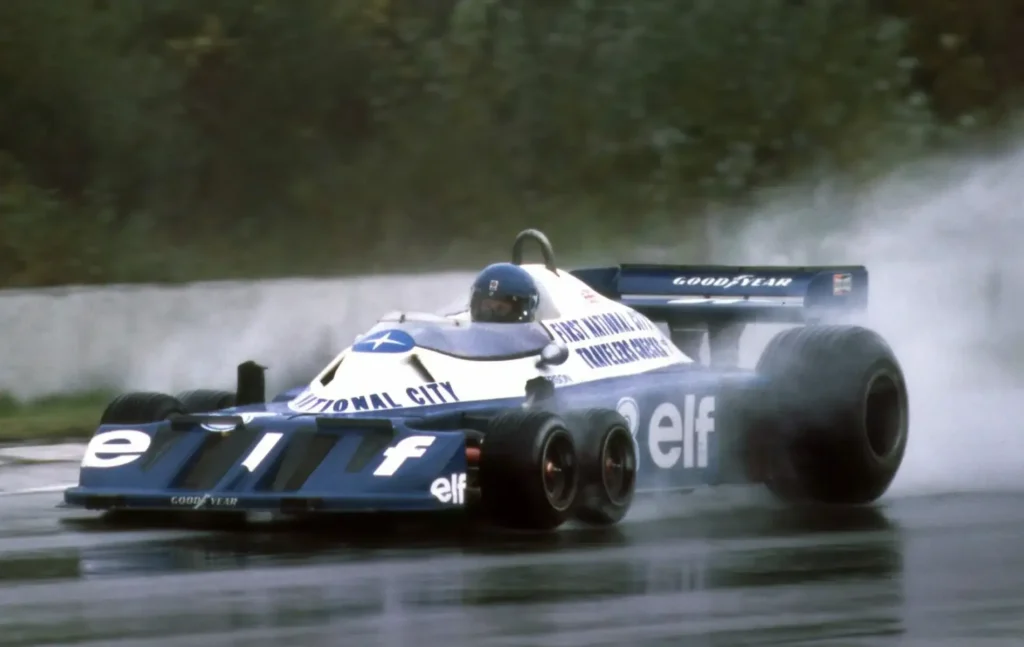
The secret project
Project 34, as it was code-named, was shrouded in secrecy from the start. Goodyear was convinced to build special 10-inch tyres for the front axle, a size more common on go-karts than Formula One cars. Only a handful of Tyrrell’s senior engineers were aware of the project, and even the drivers, Jody Scheckter and Patrick Depailler, were kept in the dark until the car’s public reveal.
When the P34 was finally unveiled at the team’s Surrey base in September 1975, the deception continued. A sheet was thrown over the car, the shape carefully arranged to hide the additional wheels. When the cover was lifted, revealing four diminutive front tyres, jaws dropped. What had looked like another neat Tyrrell chassis suddenly became something out of science fiction. Journalists scrambled for their cameras; Scheckter reportedly laughed in disbelief.
It was an engineering gamble that defied convention. The front suspension was a maze of linkages connecting the leading axle to the secondary one behind, while a pair of portholes cut into the cockpit sides allowed drivers to see their outer front wheels, necessary for judging apexes. Even by Formula One’s experimental standards, the P34 was outrageous.
Early promise on track
The P34 made its competitive debut at the 1976 Spanish Grand Prix at Jarama, driven by Depailler. The radical concept sparked considerable curiosity, but few anticipated its rapid development. Instead, the Tyrrell stunned the paddock by qualifying third, behind only James Hunt in a McLaren and Niki Lauda for Ferrari. Although Depailler retired with braking problems, the car’s pace was undeniable. A fortnight later at Monaco, both Scheckter and Depailler stood on the podium behind Lauda, an extraordinary result for such an unorthodox machine.
Then came Sweden. The Anderstorp circuit was smooth, fast and perfectly suited to the P34’s aerodynamic advantages. Scheckter took pole position, Depailler lined up fourth, and the Lotus of Mario Andretti retired, leading Tyrrell to score a remarkable 1-2 finish. It was a triumph for engineering daring and an instant piece of Formula One folklore: the only six-wheeled car ever to win a Grand Prix.
-

Which F1 Team Has the Most 1-2 Finishes in Formula 1 History?
-

Which F1 Team Has the Most Front Row Lockouts In F1 history?
That season, the P34 carried Scheckter to third place in the 1976 Drivers’ Championship and Tyrrell to third in the Constructors’ standings. It was a result that few in the sport could have imagined a year earlier. Yet behind the scenes, all was not rosy.
The realities of racing six wheels
Despite its early glory, the P34’s complex design carried serious compromises. The car’s front end performed beautifully in high-speed corners, thanks to its multiple tyres providing exceptional grip and stability, but braking proved unpredictable. The dual-axle setup meant that when grip varied between the two sets of front wheels, the effective wheelbase changed mid-corner, unsettling the car.
Scheckter, despite winning with it, was never a fan. He described the P34 as “a piece of junk”, complaining that it was brilliant one moment and hopeless the next. Depailler, by contrast, adored the car. Its darting front end and lively handling suited his flamboyant style. But both drivers agreed on one issue: tyre development.
Goodyear had originally produced the bespoke front tyres with enthusiasm, but as the 1976 season wore on, the American tyre giant shifted focus back to the standard-size rubber used by all other teams. While the rear tyres continued to evolve, the small front ones stagnated. The P34’s balance, once its greatest strength, began to slip away.
The 1977 season and the beginning of the end
For 1977, Tyrrell introduced the P34B, a refined version with a wider front track and revised aerodynamics. On paper, it should have addressed some of the original’s shortcomings. In practice, it was a disappointment. The increase in width exposed the small front wheels to the airflow that the design had once so carefully avoided, undermining its aerodynamic concept. Braking remained inconsistent, and the larger bodywork made the car heavier.
Depailler soldiered on, extracting flashes of pace, while new recruit Ronnie Peterson never truly bonded with the car. Tyrrell slipped down the order, finishing far off the championship’s front runners. By the end of the year, Ken Tyrrell had seen enough. The team reverted to a conventional four-wheeled car for 1978, quietly drawing a line under one of the most audacious experiments in Formula One history.
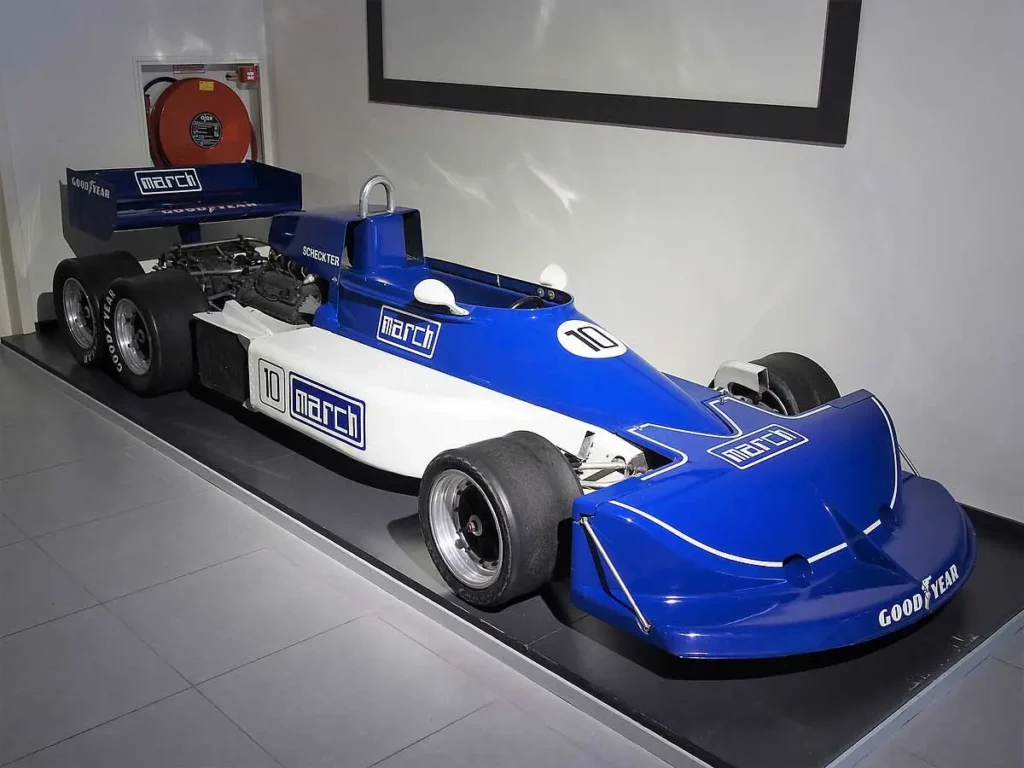
Copycats and consequences
Even in failure, innovation rarely goes unnoticed. The sight of Tyrrell’s six-wheeler dominating in Sweden caught the imagination of rival engineers. Williams, March and Ferrari all explored six-wheeled designs of their own, though their approach was different. Rather than four small front wheels, they opted for four driven wheels at the rear to improve traction. Ferrari’s 312T6 and March’s 2-4-0 both ran in testing but never raced, their complexity and weight offsetting any theoretical advantage.
In 1983, the FIA outlawed multi-wheeled cars by tightening regulations, ensuring that Formula One machines would only ever have four wheels, with two of them driven. The era of the six-wheeler was over before it had properly begun.
Legacy of the P34
The Tyrrell P34 remains one of the most iconic machines ever to grace the grid. It embodied a spirit of creative problem-solving that has defined the best of Formula One engineering. Gardner’s design proved that the rulebook was not a constraint but an invitation to innovate. The fact that the P34 won a Grand Prix cemented its place in history; the fact that no other six-wheeler ever did makes it legendary.
Today, restored examples of the P34 continue to race in historic events, often on modern reproductions of the small front tyres that Goodyear once abandoned. Freed from the constraints of 1970s tyre politics, the car often performs brilliantly, suggesting that Gardner’s idea may have been sounder than its brief lifespan suggested.
Beyond its performance, the P34 also left a cultural mark. Its striking shape adorned model kits, posters and toy boxes, inspiring a generation of young fans who marvelled at the notion that a Formula One car could look so different and still win. It was proof that audacity could triumph, even if only for a fleeting moment.
A glorious curiosity
In hindsight, the Tyrrell P34 was a product of a wonderfully experimental time in Formula One. The 1970s gave us fan cars, turbine engines, sliding skirts and ground effect, all born from clever interpretations of loosely worded regulations. Among them, the six-wheeler stands out as perhaps the boldest of all.
It was not perfect, nor particularly practical, but it was daring. It challenged assumptions about what a racing car could be and, in doing so, reminded everyone that progress often comes from those willing to look foolish before they look brilliant. In the history of Formula One, the Tyrrell P34 occupies a special place. It is both a technical curiosity and a symbol of imagination unbound, a reminder that sometimes, to get ahead, you have to add a few extra wheels.
Frequently Asked Questions
-
Why was Tyrrell P34 banned?
The Tyrrell P34 itself was never directly banned, but its concept became impossible to pursue after Formula One regulations were tightened in 1983. The FIA ruled that all cars must have four wheels, with only two driven, effectively outlawing six-wheelers. Tyrrell had already abandoned the design in 1978 due to a lack of tyre development and increasing complexity.
-
Did the Tyrrell P34 ever win a race?
Yes. The Tyrrell P34 achieved a famous victory at the 1976 Swedish Grand Prix in Anderstorp. Jody Scheckter led teammate Patrick Depailler to a one–two finish, making it the only six-wheeled car ever to win a Formula One race.
-
Why does Tyrrell P34 have 6 wheels?
Designer Derek Gardner created the six-wheeled P34 to solve an aerodynamic problem. Formula One rules limited front wing width, leaving large front tyres exposed to airflow. Gardner’s idea was to use four smaller front wheels tucked behind the wing, reducing drag while maintaining grip. The result was a radical but effective innovation.
-
How many Tyrrell P34 were made?
Tyrrell built a total of six P34 chassis between 1975 and 1977. These included the original development cars and the updated P34B models for the 1977 season. Several of these chassis survive today, restored and still racing in historic Formula One events.
Seen in:

